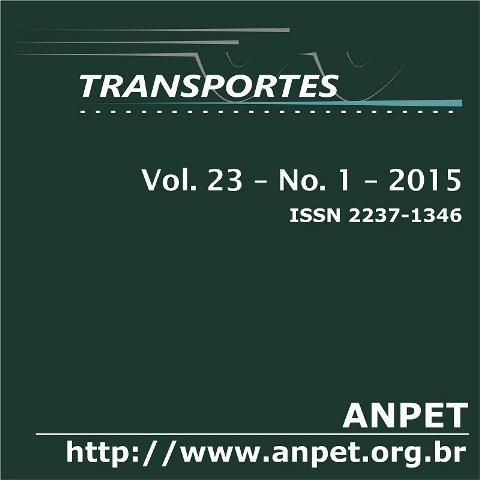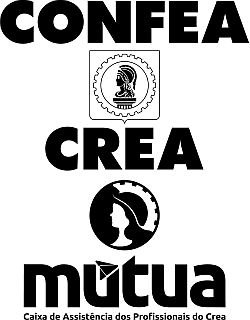Calibración del modelo de capacidad de rotondas del HCM2010 a condiciones locales: caso Córdoba, Argentina
DOI:
https://doi.org/10.14295/transportes.v23i1.832Palavras-chave:
rotondas, intervalo crítico, intervalo de seguimiento.Resumo
El presente trabajo presenta la calibración de los parámetros relevantes, intervalo crítico y de seguimiento, del modelo de capacidad de rotondas propuesto en la metodología del Highway Capacity Manual (TRB, 2010) a condiciones locales de la Provincia de Córdoba – Argentina. El estudio fue efectuado en cuatro rotondas urbanas. Se realizaron filmaciones en horas de mayor tránsito, para extraer muestras representativas y calcular los parámetros de calibración del modelo. Estos son el intervalo crítico y el intervalo de seguimiento. Se empleó el método de Máxima Verosimilitud, la Regresión Lineal y la Medición Directa para estimar los valores correspondientes. Se determinó que es posible adecuar el modelo de capacidad del HCM2010 contemplando el comportamiento de los conductores locales en función de los parámetros indicados. Se concluye que, a través de una comparación con modelos calibrados en otros países, los conductores locales presentan intervalos crítico y de seguimiento menores, lo que genera una capacidad mayor en desmedro de la seguridad. Se proponen los valores de intervalos locales que contemplen la adecuación de los modelos.
Downloads
Referências
ALBRIEU, M. y GALARRAGA, J. (2012) Recomendaciones para la aplicación de la metodología del HCM para intersecciones semaforizadas en Argentina. XVI Congreso Argentino de Vialidad y Tránsito, Córdoba, Argentina.
BRILON, W., KÖNIG, R. y TROUTBECK, R. (1997) Useful Estimation Procedures for Critical Gaps. Proceeding of Third Int. Symposium on Intersections without Traffic Signals, Portland, Oregon, U.S.A. DOI: 10.1016/S0965-8564(98)00048-2
CAIMI, M. (2008) Rotondas: Estimación del Intervalo Crítico y del Tiempo de Seguimiento y su Aplicación en las Medidas de Eficiencia, Disertación Maestría en Ciencias de la Ingeniería Mención en Transporte, Facultad de Ciencias Exactas, Físicas y Naturales, Universidad Nacional de Córdoba, Argentina.
CANAVOS, G. (1988) Probabilidad y Estadística, Aplicaciones y Métodos, Editorial McGraw Hill, México, DF.
DEPIANTE, V. y GALARRAGA, J. (2013) Minor Street Gaps and Capacity at Unsignalized Intersections in Argentina. XIII WCTR, Rio de Janeiro, Brasil.
FLORES CASTELLANO, G. J. (2013) Capacidad de Rotondas: Calibración del Modelo del HCM 2010 a Condiciones Locales. Disertación Maestría en Ciencias de la Ingeniería Mención en Transporte. Facultad de Ciencias Exactas, Físicas y Naturales, Universidad Nacional de Córdoba, Argentina.
GARBER, N. y HOEL, L. (2007) Ingeniería de Tránsito y Ca-rreteras, 3ra edición, Cengage Learning, México, D.F.
GAZZARRI A., MARTELLO M. T., PRATELLI1 A. AND SOULEYRETTE R. R. (2012) Estimation of gap acceptance parameters for HCM 2010 roundabout capacity model applica-tions. WIT Transactions on The Built Environment, Vol 128, WIT Press, ISSN 1743-3509 (on-line) DOI: 10.2495/UT120271
HARDERS, J. (1968) Die Leistungs faehigkeitnicht signal ger-egelter staedtischer Verkehrsknoten (Capacity of unsignalized urban intersections). Strassenbau und Strassenverkehrstechnik, Vol. 76. Bundesministerfuer Verkehr, Abt. Strassenbau, Bonn.
KYTE, M., TIAN, Z., MIR, Z., HAMEEDMANSOOR, Z., KITTELSON, W., VANDEHEY, M., ROBINSON, B., BRI-LON, W., BONDZIO, L., WU, N. y TROUTBECK, R. (1996) Capacity and Level of Service at Unsignalized Intersections. Final Report: Volume 1. National Cooperative Highway Research Program 3-46.
RAFF, M. y HART, J. (1950) A volume warrant for urban stop sign. The Eno Foundation for Highway Traffic Control.
SIEGLOCH, W. (1973) Capacity calculations for unsignalized intersections. Schriftenreihe Strassenbau, Vol. 154.
NCHRP Report 572 (2007) Roundabouts in the United States, National Cooperative Highway Research Program, Transportation Research Board of the National Academies, Washington D.C., USA.
NCHRP Report 672 (2010) Roundabouts: A Informational Guide, Second Edition, National Cooperative Highway Research Program, Transportation Research Board of the National Acade-mies, Washington D.C., USA.
TRB (2010) Highway Capacity Manual. Chapter 21: Rounda-bouts, Volumen 3: Interrupted Flow, Transportation Research Board of the National Academies, Washington D.C., USA.
TROUTBECK, R. (1992) Estimating the critical acceptance gap from traffic movements, Queensland University of Technology, Australia.
TROUTBECK, R. y BRILON, W. (1996) Unsignalized Intersec-tion Theory. Chapter 8, página de internet: http://www.fhwa.dot.gov/publications/research/operations/tft/chap8.pdf
XU, F. y TIAN, Z. (2007) Roundabout Geometric Design Guid-ance. Report N° F/CA/RI-2006/13 California Department of Transportation, Department of Civil Engineering, California State University, U.S.A.
Downloads
Publicado
Como Citar
Edição
Seção
Licença
Ao submeter um manuscrito para publicação neste periódico, todos os seus autores concordam, antecipada e irrestritamente, com os seguintes termos:
- Os autores mantém os direitos autorais e concedem à Transportes o direito de primeira publicação do manuscrito, sem nenhum ônus financeiro, e abrem mão de qualquer outra remuneração pela sua publicação pela ANPET.
- Ao ser publicado pela Transportes, o manuscrito fica automaticamente licenciado sob a Licença Creative Commons CC BY 4.0. Esta licença permite o seu compartilhamento com reconhecimento da autoria e da publicação inicial neste periódico.
- Os autores têm autorização para assumir contratos adicionais separadamente, para distribuição não exclusiva da versão do trabalho publicada neste periódico (por ex.: publicar em repositório institucional ou como capítulo de livro), com reconhecimento da publicação inicial na Transportes, desde que tal contrato não implique num endosso do conteúdo do manuscrito ou do novo veículo pela ANPET.
- Os autores têm permissão e são estimulados a publicar e distribuir seu manuscrito online (por ex.: em repositórios institucionais ou na sua página pessoal) depois de concluído o processo editorial. Como a Transportes é de acesso livre, os autores são estimulados a usar links para o DOI do artigo nesses casos.
- Os autores garantem que obtiveram todas as permissões necessárias dos empregadores para a publicação e o licenciamento CC BY 4.0 do manuscrito, especialmente se o empregador possuir alguma reivindicação sobre os direitos autorais do manuscrito. Os autores assumem total responsabilidade por questões de direitos autorais relacionadas ao empregador, isentando a ANPET e a Transportes de qualquer responsabilidade relacionada.
- Os autores assumem toda responsabilidade sobre o conteúdo do manuscrito, incluindo as devidas e necessárias autorizações para divulgação de dados coletados e resultados obtidos, isentando a ANPET e a Transportes de toda e qualquer responsabilidade neste sentido.
Última atualização: 27/11/2025











